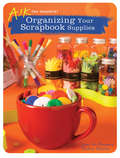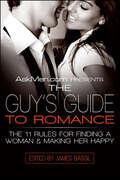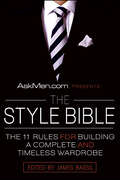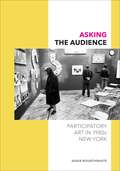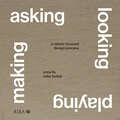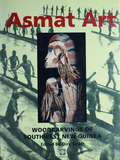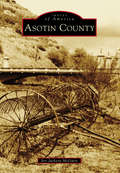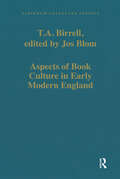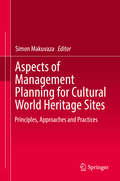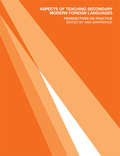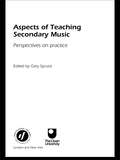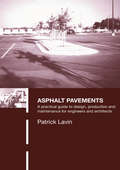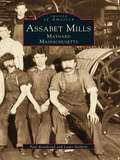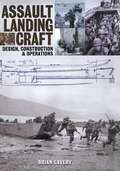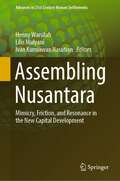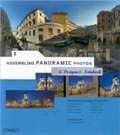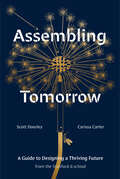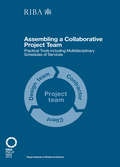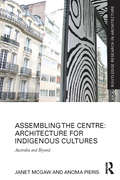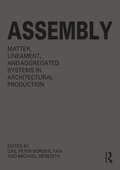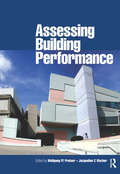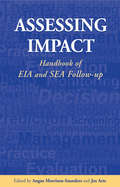- Table View
- List View
Ask the Masters! Organizing Your Scrapbook Supplies
by Christine Doyle Jessica Strawser Eileen AberWhen scrapbook supplies start to overtake your workspace, know that you're not alone. Just Ask the Masters! In Organizing Your Scrapbook Supplies, the Memory Makers Masters have joined forces to help you make the most of your space and your stash. Whether you have a designated scrap room or a coveted seat at the kitchen table, getting organized will make you more efficient, more productive and even more creative. Learn to: Create a storage system that works for you regardless of the size of your space. Organize everything from runaway rub-ons to tangled ribbon to neglected digital photo files. Craft innovative and affordable space savers, such as repurposing hanging shoe holders for your chipboard alphabet, tackle boxes for your brads, and spice racks for your prettiest stamps. Be ready to crop on the go at a moment's notice. With sidebars full of bonus tips and a gallery of layouts from the Masters, Organizing Your Scrapbook Supplies will have you bursting with inspiration. Get organized like a Master and soon you'll be feeling like one, too!
AskMen.com Presents The Guy's Guide to Romance: The 11 Rules for Finding a Woman & Making Her Happy (Askmen.com Series #3)
by James BassilThe Guy's Guide to Romance is an indispensable handbook filled with fundamentals that every man can use to enter into or maintain a happy, healthy relationship. Divided into 11 rules, The Guy's Guide to Romance helps you cater to your girlfriend's wants and needs and teaches you how to get her to do the same for you. You'll learn how to handle arguments and jealousy, how to live together without driving each other crazy, and how to balance your social life with your romantic life. From the first date to the marriage proposal, from meeting her family to keeping the relationship exciting, The Guy's Guide to Romance is essential reading for every man who wants to get a great girl—and keep her.
AskMen.com Presents The Style Bible: The 11 Rules for Building a Complete and Timeless Wardrobe (Askmen.com Series #2)
by James BassilThe Style Bible is an indispensable handbook filled with fundamentals that every man can use to improve his dress sense and lifestyle. Divided into 11 rules, The Style Bible helps you build a versatile wardrobe; coordinate different colors, patterns, and accessories; learn which clothes flatter your body type; and navigate the worlds of shoes, jeans, and watches. You'll also learn how to dress appropriately for any occasion or environment, from meetings at the office to first dates and nights on the town. With instructive illustrations and loads of tips, The Style Bible is essential reading for every man who wants to dress to impress.
Asking the Audience: Participatory Art in 1980s New York
by Adair RounthwaiteThe 1980s was a critical decade in shaping today&’s art production. While newly visible work concerned with power and identity hinted at a shift toward multiculturalism, the &‘80s were also a time of social conservatism that resulted in substantial changes in arts funding. In Asking the Audience, Adair Rounthwaite uses this context to analyze the rising popularity of audience participation in American art during this important decade.Rounthwaite explores two seminal and interrelated art projects sponsored by the Dia Art Foundation in New York: Group Material&’s Democracy and Martha Rosler&’s If You Lived Here…. These projects married issues of social activism—such as homelessness and the AIDS crisis—with various forms of public participation, setting the precedent for the high-profile participatory practices currently dominating global contemporary art. Rounthwaite draws on diverse archival images, audio recordings, and more than thirty new interviews to analyze the live affective dynamics to which the projects gave rise. Seeking to foreground the audience experience in understanding the social context of participatory art, she argues that affect is key to the audience&’s ability to exercise agency within the participatory artwork.From artists and audiences to institutions, funders, and critics, Asking the Audience traces the networks that participatory art creates between various agents, demonstrating how, since the 1980s, leftist political engagement has become a cornerstone of the institutionalized consumption of contemporary art.
Asking, Looking, Playing, Making: A nature-focused design process
by Mike Tonkin Anna LiuDesign is a process requiring both rigour and freedom; focus and expansion. Yet how does the concept - the 'intention' - become a built project?This accessible book acts as a storytelling toolkit, taking designers through a tried-and-tested process for taking an architectural project from thought to built project. Based around four main sections - Asking, Looking, Playing and Making - the authors show how a design process can generate beautiful buildings which are rooted in a sense of place. Further examples include a range of project types and scales to demonstrate the versatility of this toolkit.
Asmat Art
by Dirk SmidtThis book presents a full range of Asmat woodcarving art, but emphasizes the rare early shields and figure sculptures in the collection of the Rijksmuseum voor Volkenkunde, the National Museum of Ethnology in Leiden. Drums, canoeprowheads and the larger, more dramatic "objects" are also shown. * Together with bisj poles, war shields are perhaps the most famous creation of Asmat artists, and these were carved throughout the region. It is in the design and construction of the shields that the variations in style region can most clearly be seen. Figure sculptures, of varying styles, are also well represented here, and a limited number of the huge ceremonial carvings, such as bisj poles and basu suangkus, have also been included. The cultural context in which these items play their part is described in detail in the introductory chapters. But it is not the intention of this book to be an ethnography. The focus is on the art pieces themselves.
Asmat Art
by Dirk SmidtThis book presents a full range of Asmat woodcarving art, but emphasizes the rare early shields and figure sculptures in the collection of the Rijksmuseum voor Volkenkunde, the National Museum of Ethnology in Leiden. Drums, canoeprowheads and the larger, more dramatic "objects" are also shown. * Together with bisj poles, war shields are perhaps the most famous creation of Asmat artists, and these were carved throughout the region. It is in the design and construction of the shields that the variations in style region can most clearly be seen. Figure sculptures, of varying styles, are also well represented here, and a limited number of the huge ceremonial carvings, such as bisj poles and basu suangkus, have also been included. The cultural context in which these items play their part is described in detail in the introductory chapters. But it is not the intention of this book to be an ethnography. The focus is on the art pieces themselves.
Asotin County (Images of America)
by Jeri Jackson McguireAsotin, Anatone, Cloverland, Clarkston, and Silcott are all towns within Asotin County, an area rich in local history. Names like Lewis and Clark, Chief Joseph, Capt. Benjamin Bonneville, Capt. Edward Steptoe, Chief Looking Class, Chief Timothy, and Henry Spaulding all had early ties to the area. Asotin was carved out of Garfield County on October 27, 1883. There are fascinating stories of early pioneers, such as Weissenfels, Floch, Wilson, Stone, Critchfield, Halsey, and many more, who came from far and wide to settle the area, becoming farmers, building towns, and establishing an irrigation system. Through the years, Asotin has encountered floods, murders, hangings, a disastrous fire, and a fight to retain the county seat. At one point, the residents thought they might have to battle the Nez Perce Indians, but they were peaceful and very kind to the people.
Aspects of Book Culture in Early Modern England (Variorum Collected Studies)
by T.A. Birrell edited by BlomThomas Anthony Birrell (1924-2011) was a man of many parts. For most of his working life he was Professor of English Literature in the University of Nijmegen, The Netherlands, where he was famous for his lively, humoristic and thought-provoking lectures. He was the author of some very popular literary surveys in Dutch, one of which - a history of English literature - has had seven editions so far. However, first and foremost he was a bibliographer and a book historian. The present collection contains fifteen of his book-historical articles, two reviews and one published version of a lecture for the illustrious ’Association Internationale de Bibliophilie’. The lecture - with a wealth of illustrations - about the British Library as the ’Custodian of the Unique’ gives one a sense of Birrell’s ability to present an audience with a complicated topic in comprehensible, but not simplified, terms. The reviews serve as a statement of principle of how to tackle the subject of ’English readers and books’ and the standards that ought to apply. The articles demonstrate Tom Birrell’s in-depth knowledge, dedication and scholarship. He once said that he felt that he could have talked to the 17th-century London booksellers on an equal footing and his work convinces one that they would have enjoyed these conversations. Aspects of Book Culture was edited by Birrell’s former pupil, colleague, friend and fellow-bibliographer Jos Blom.
Aspects of Management Planning for Cultural World Heritage Sites: Principles, Approaches and Practices
by Simon MakuvazaReviews links and synergies with other legal instruments such as the UNESCO Recommendation on International Principles Applicable to Archaeological Excavations and the Convention on the Means of Prohibiting and Preventing the Illicit Import, Export and Transfer of Ownership of Cultural Property.<P><P> Highlights implementation and effectiveness of such participation strategies with regard to the management of World Heritage Sites.<P> Archaeological World Heritage sites offer invaluable information on the past of humankind for present and future generations, thereby contributing to long-term sustainable development in line with the recently adopted World Heritage Sustainable Development Policy.<P> Every site that is inscribed on the World Heritage List (WHL) must have a management plan or some other management system. According to the UNESCO Operational Guidelines, the purpose of a management plan is to ensure the effective protection of the nominated property for present and future generations. This requirement was in part necessitated by the need to implement real systems of monitoring on the management of World Heritage Sites.<P> Since its implementation in 2005, discussion on the function and the contents of management plans for World Heritage Sites has grown tremendously. The discussions have mainly been focused on the theoretical frameworks of World Heritage site management plans and proposals of practical guidelines for their implementation.<P> This volume provides a platform for heritage practitioners, especially those working at Cultural World Heritage Sites, to put in writing their experiences and impressions about the implementation of site management plans at properties that are inscribed on the WHL. Cultural World Heritage Sites in this case refer to world heritage properties such as archaeological sites, cultural landscapes, religious sites and architectural structures. The book also seeks to examine the extent to which site management plans have been or are being implemented at Cultural World Heritage Sites.
Aspects of Teaching Secondary Modern Foreign Languages: Perspectives on Practice
by Ann SwarbrickThis lively and inspiring collection of readings is divided into three sections: 'Developing teaching strategies and effective classroom management' covers all major aspects of classroom practice; 'Planning, evaluating and assessing MFL learning' is a guide to the day to day requirements and practicalities of MFL teaching; 'In search of a wider perspective' considers how MFL teaching might develop and expand, and its place outside the classroom. Fully engaged with teaching and learning MFL at a practical level, it illustrates concepts and good practice through a braod range of classroom-based examples and case studies.Issues covered in this book include: maximising potential engaging pupils in their learning developing listening, reading and oral skills use of information communication technology assessment and differentiation broadening the content of MFL lessons role play in the language class MFL beyond the classroom.
Aspects of Teaching Secondary Music: Perspectives on Practice
by Gary SpruceAspects of Teaching Secondary Music provides a practical illustration of the skills, knowledge and understanding required to teach music in the secondary classroom. Musical concepts and ideas are discussed and a critical examination of key issues is given. This encourages the reader to engage with these thoughts and consider their views and beliefs in terms of how they will influence their potential to teach music in an inspired and effective manner.
Asphalt Pavements: A Practical Guide to Design, Production and Maintenance for Engineers and Architects
by Patrick LavinAsphalt Pavements provides the know-how behind the design, production and maintenance of asphalt pavements and parking lots. Incorporating the latest technology, this book is the first to focus primarily on the design, production and maintenance of low-volume roads and parking areas.Special attention is given to determining the traffic capacity, re
Assabet Mills: Maynard, Massachusetts
by Lewis Halprin Paul BoothroydThe sleepy town of Assabet Village woke up very quickly when the Assabet Mills was built in 1847. Dams were constructed on the river, millponds were created, and large mills began producing yarn and carpets. Soon the village was turning into a town with stores, churches, schools, and government. As the mill grew, so did the town; the population grew to 7,000 people by 1905. During good times, the mill prospered, but during bad times, it faltered and had to re-invent itself. It had almost as many lives asthe proverbial cat. The carpet mill faltered in 1857, but in 1862, the Assabet Manufacturing Company started producing woolen materials and blankets to support the Civil War. This mill faltered in 1898, but in 1899, the American Woolen Company bought themills and greatly expanded them. In 1950, the woolen company faltered and shut down completely, but in 1957, Digital Equipment moved in. Digital faltered in 1997 and sold the buildings to Clock Tower Place, which is converting the mills into first-class industrial space. Today, the mills are attracting a new set of small industries. This book is filled with images of the various "lives" of the mill complex. Photographs featured within these pages show mill employees at work and at play; workers' homes; the evolution of the mill buildings; and the products produced and sold by the mill. There is even a chapter that shows how wool products are produced.
Assault Landing Craft: Design, Construction & Operators
by Brian LaveryThe landing craft assault or LCA was one of the unsung heroes of the Second World War. It took part in practically every amphibious operation from Norway to Normandy and landed around 400,000 men in action conditions, plus many more in training. It was the only serviceable British landing craft at the beginning of the War, and it remained in service until the Suez operation of 1956. It landed the first waves of infantry on the British and Canadian beaches in Normandy in 1944, and Americans on the notorious Omaha Beach. Its far-sighted design of 1938 remains the basis for the landing craft of today.This is the first book devoted to this humble but essential craft. It examines its design history before the War, when amphibious operations were deeply unfashionable. It describes its design and construction with plans that will be useful to modellers and wargamers. It includes information on the role of the crew and the techniques and tactics used in landings. It gives an account of the larger ships which carried it and the life of the sailors and soldiers who travelled in it, with many vivid personal accounts. Finally, it describes its role in the many operations in which it took part, including withdrawals such as Dunkirk and the catastrophic Dieppe raid of 1942.
Assembling Nusantara: Mimicry, Friction, and Resonance in the New Capital Development (Advances in 21st Century Human Settlements)
by Lilis Mulyani Henny Warsilah Ivan Kurniawan NasutionToday, the new Indonesian capital city, Nusantara, planning is being anticipated as “representing national identity,” “a model city,” or “a gift to the world,” and many other extraordinary labels. This book examines the reality of an ongoing developmental transformation of the Nusantara beyond those labels. It approaches its assemblage of humans, their works (plans, documents, policies, and others), non-human objects (biodiversity, landscape, geography, physical infrastructure, buildings, and public spaces), processes, social relationships, social infrastructures, and others. It is organized into three themes—mimicry, friction, and resonance. The mimicry illustrates the similarities (and differences) between Nusantara and other capital cities in urban narratives, imageries, and forms. The friction studies how Nusantara moves actors who do not always agree, processes that do not always align or collaboration between diverse contradicting groups that intersect. The resonance observes how Nusantara resonates with, yet communicates its voice toward, the world. The three concepts (originated from geography, anthropology, and sociology) frame the analytics of the various contributions of local and foreign scientists from multiple disciplines. Overall, the book recommends “Otorita Ibu Kota Nusantara” (Nusantara capital city authority) on the current experimentation and implementation of the urban vision and provides a reference for social scientists to study Nusantara. And more broadly, the book offers the current socio-spatial practices of capital city-making in Asia that are valuable for the region.
Assembling Panoramic Photos: A Designer's Notebook
by William RodarmorIn this full-color Designer's Notebook, eight expert French photographers reveal their secrets in using Photoshop and a collection of dedicated applications to create extraordinary panoramic photos--including some amazing 360-degree images. For anyone involved with digital imagery or animation, this groundbreaking volume demonstrates a new way of thinking about what's possible and what's required to produce these images. Originally published in France, Assembling Panoramic Photos: A Designer's Notebook is available in English for the first time. Part art book, part how-to guide, this stunning work takes you right into the studio and sits you down next to renowned digital artists as they advance step-by-step toward their final images. The showcased pieces are inspiring and avant-garde, and the techniques are instructive for a wide range of amateur and professional photographers, graphic designers, and digital artists. The artists featured in this Designer's Notebook show how they use Photoshop, Stitcher, PanaVue ImageAssembler, and other specialized tools to create high-quality panoramas and wide-angle images from a series of photos. They also show how to create virtual reality scenes with Apple's QuickTime VR in conjunction with leading-edge technologies that support 360-degree one-shot photos, cubic images, and 3D views of objects. The results are interactive, often startling, and bear the hallmark of each artist's original vision and skill. Reflecting the very best of French photography, graphic design and digital artistry, Assembling Panoramic Photos: A Designer's Notebook offers advanced Photoshop instruction that goes beyond opening this menu, or clicking that palette. You receive expert aesthetic guidance, from start to finish, with notes and views that reveal every step of the process. This book is a goldmine for any digital artist who wants to learn new Photoshop techniques and exploit them for maximum effect. At home on either your coffee table or desktop, the book itself is dazzling in concept and design. There's nothing else quite like this Designer's Notebook available in the U.S.
Assembling Tomorrow: A Guide to Designing a Thriving Future from the Stanford d.school (Stanford d.school Library)
by Scott Doorley Stanford d.school Carissa CarterA powerful guide to why even the most well-intentioned innovations go haywire, and the surprising ways we can change course to create a more positive future, by two celebrated experts working at the intersection of design, technology, and learning at Stanford University&’s acclaimed d.school.&“This brilliant book offers a new approach to all creative work that will expand your understanding of what it means to make and open up possibilities you didn&’t know existed—it did for me.&”—Adam Johnson, Pulitzer Prize-winning author of The Orphan Master&’s SonIn Assembling Tomorrow, authors Scott Doorley and Carissa Carter explore the intangible forces that prevent us from anticipating just how fantastically technology can get out of control, and what might be in store for us if we don&’t start using new tools and tactics. Despite our best intentions, our most transformative innovations tend to have consequences we can&’t always predict. From the effects of social media to the uncertainty of AI and the consequences of climate change, the outcomes of our creations ripple across our lives. Time and again, our seemingly ceaseless capacity to create rubs up against our limited capacity to understand our impact. Assembling Tomorrow explores how to use readily accessible tools to both mend the mistakes of our past and shape our future for the better. We live in an era of &“runaway design,&” where innovations tangle with our lives in unpredictable ways. This book explores the off-kilter feelings of today and follows up with actionables to alter your perspective and help you find opportunities in these turbulent times. Mixed throughout are histories of the future, short pieces of speculative fiction that imagine the future as if it has already happened and consider the past with a critical yet hopeful eye so that all of us—as designers of our own futures—can create a better world for generations to come.
Assembling a Collaborative Project Team: Practical tools including Multidisciplinary Schedules of Services
by Dale SinclairContemporary construction practice presents a shift in emphasis from thinking about the design team in isolation, to considering the project team as a collaborative whole: client, design team, and contractor. This approach requires greater consideration of how the project team is procured and assembled – and Assembling a Collaborative Project Team provides a range of in-depth and invaluable methods for ensuring that this essential task is carried out effectively. It will bring a range of benefits to any project – from facilitating BIM-ready teams, to better construction programming, and reducing risk through ensuring a watertight contractual framework. Many of the methods presented here are likely to become ingrained in the way all projects are coordinated. It shows that the best way of assembling a collaborative team is by establishing the team at the outset in manner that ensures that each party is fully aware of what they need to do and when, and by agreeing how this will be achieved.
Assembling the Centre: Australia and Beyond (Routledge Research in Architecture)
by Anoma Pieris Janet McGawMetropolitan Indigenous Cultural Centres have become a focal point for making Indigenous histories and contemporary cultures public in settler-colonial societies over the past three decades. While there are extraordinary success stories, there are equally stories that cause concern: award-winning architecturally designed Indigenous cultural centres that have been abandoned; centres that serve the interests of tourists but fail to nourish the cultural interests of Indigenous stakeholders; and places for vibrant community gathering that fail to garner the economic and politic support to remain viable. Indigenous cultural centres are rarely static. They are places of ‘emergence’, assembled and re-assembled along a range of vectors that usually lie beyond the gaze of architecture. How might the traditional concerns of architecture – site, space, form, function, materialities, tectonics – be reconfigured to express the complex and varied social identities of contemporary Indigenous peoples in colonised nations? This book, documents a range of Indigenous Cultural Centres across the globe and the processes that led to their development. It explores the possibilities for the social and political project of the Cultural Centre that architecture both inhibits and affords. Whose idea of architecture counts when designing Indigenous Cultural Centres? How does architectural history and contemporary practice territorialise spaces of Indigenous occupation? What is architecture for Indigenous cultures and how is it recognised? This ambitious and provocative study pursues a new architecture for colonised Indigenous cultures that takes the politics of recognition to its heart. It advocates an ethics of mutual engagement as a crucial condition for architectural projects that design across cultural difference. The book’s structure, method, and arguments are dialogically assembled around narratives told by Indigenous people of their pursuit of public recognition, spatial justice, and architectural presence in settler dominated societies. Possibilities for decolonising architecture emerge through these accounts.
Assembly by Design: The United Nations and Its Global Interior (Buell Center Books in the History and Theory of American Architecture)
by Olga TouloumiHow the United Nations headquarters became the architectural instrument and broadcast medium of global diplomacy For almost seven years after World War II, a small group of architects took on an exciting task: to imagine the spaces of global governance for a new political organization called the United Nations (UN). To create the iconic headquarters of the UN in New York City, these architects experimented with room layouts, media technologies, and design in tribunal courtrooms, assembly halls, and council chambers. The result was the creation of a new type of public space, the global interior. Assembly by Design shows how this space leveraged media to help the UN communicate with the world. With its media infrastructure, symbols, acoustic design, and architecture, the global interior defined political assembly both inside and outside the UN headquarters, serving as the architectural medium to organize multilateral encounters of international publics around the globe. Demonstrating how aesthetics have long held sway over political work, Olga Touloumi posits that the building framed diplomacy on the ground amid a changing political landscape that brought the United States to the forefront of international politics, destabilizing old and establishing new geopolitical alliances. Uncovering previously closed institutional and family archives, Assembly by Design offers new information about the political and aesthetic decisions that turned the UN headquarters into a communications organism. It looks back at a moment of hope, when politicians, architects, and diplomats—believing that assembly was a matter of design—worked together to deliver platforms for global democracy and governance.
Assembly: Matter, Lineament, and Aggregated Systems in Architectural Production
by Michael Meredith Gail Peter BordenPart-to-part relationships and the approach to governing their sensibilities is at the root of all architecture. The need for engaging in a dialogue around these systems is essential to contemporary architectural discourse and practice. Assembly builds on and extends the investigations of materials and representation techniques in the editors’ previous books, Matter and Lineament. This book uses a collection of detailed case studies, explained by first-person authors, about experimental and innovative takes on assembling architecture. Bridging theory and practice, 17 projects and their principled approaches each demonstrate an important vein of inquiry within the topic. Essays probe issues such as latent and overt geometry, fabrication and technology, part-to-part elements, joinery and representation, material vernacular geometries, labor and place-based contextual assemblies, detailing, and pedagogical examinations. This text articulates the traditions and trends of material as the defining premise in the contemporary making of architecture. Its outcomes are applicable to beginning students of architecture and advanced practitioners alike.
Assessing Building Performance
by Wolfgang F.E. Preiser Jacqueline C. VischerThe building performance evaluation (BPE) framework emphasizes an evaluative stance throughout the six phases of the building delivery and life cycle: (1) strategic planning/needs analysis; (2) program review; (3) design review; (4) post-construction evaluation/review; (5) post-occupancy evaluation; and, (6) facilities management review/adaptive reuse.The lessons learned from positive and negative building performance are fed into future building delivery cycles. The case studies illustrate how this basic methodology has been adapted to a range of cultural contexts, and indicates the positive results of building performance assessment in a wide range of situations.
Assessing Expressive Learning: A Practical Guide for Teacher-directed Authentic Assessment in K-12 Visual Arts Education
by Charles M. Dorn Robert Sabol Stanley S. Madeja F. Robert SabolAssessing Expressive Learning is the only book in the art education field to date to propose and support a research-supported teacher-directed authentic assessment model for evaluating K-12 studio art, and to offer practical information on how to implement the model. This practical text for developing visual arts assessment for grades 1-12 is based on and supported by the results of a year-long research effort primarily sponsored by the National Endowment for the Arts, involving 70 art teachers and 1,500 students in 12 school districts in Florida, Indiana, and Illinois. The purpose of the study was to demonstrate that creative artwork by K-12 students can be empirically assessed using quantitative measures that are consistent with the philosophical assumptions of authentic learning and with the means and ends of art, and that these measures can reliably assess student art growth. A further goal was to provide a rationale for the assessment of student art as an essential part of the K-12 instructional program and to encourage art teachers to take responsibility for and assume a leadership role in the assessment of art learning in the school and the school district. Assessing Expressive Learning: *reports on current assessment methods but also stresses a time-tested portfolio assessment process that can be used or adapted for use in any K-12 art classroom; *includes the assessment instruments used in the study and several case studies of art teachers using electronic portfolios of student work, a bibliography of major art assessment efforts, and a critical review of current methods; *is designed to be teacher- and system-friendly, unlike many other art assessment publications that provide only a review of information on assessment; and *both documents an experiment where artistic values and aesthetic issues were considered paramount in the education of K-12 students in the visual arts, and also serves as a guide for the conduct of similar experiments by art teachers in the nation's schools--the research methodology and results are reported in an appendix in a format that will enable educational researchers to duplicate the study. This volume is ideal as a text for upper-division undergraduate and graduate classes in visual arts education assessment, and highly relevant for college art education professors, researchers, and school district personnel involved in the education and supervision of art teachers, and researchers interested in performance measurement.
Assessing Impact: Handbook of EIA and SEA Follow-up
by Jos Arts Angus Morrison-SaundersWritten and edited by an authoritative team of internationally known experts in environmental impact assessment (EIA), this is the first book to present in a coherent manner the theory and practice of EIA and strategic environmental assessment (SEA) follow-up. Without some form of follow-up, the consequences of impact assessments and the environmental outcomes of development projects will remain unknown. Assessing Impact examines both EIA follow-up and the emerging practice of SEA follow-up, and showcases follow-up procedures in various countries throughout Europe, North America and Australasia. Theoretical and legislative perspectives are examined in the light of detailed case study examples, and the authors present a micro-, macro- and meta scale analysis of EIA practice ranging from individual plan and project level through to the jurisdictional level, as well as an analysis of the concept of EIA. Full coverage is given to the roles of proponents, both private and governmental, EIA regulators and the affected public in designing and executing follow-up programmes. This book is the must-have tool for impact assessment professionals, academics, regulators and proponents working on projects of all scales in all jurisdictions.
